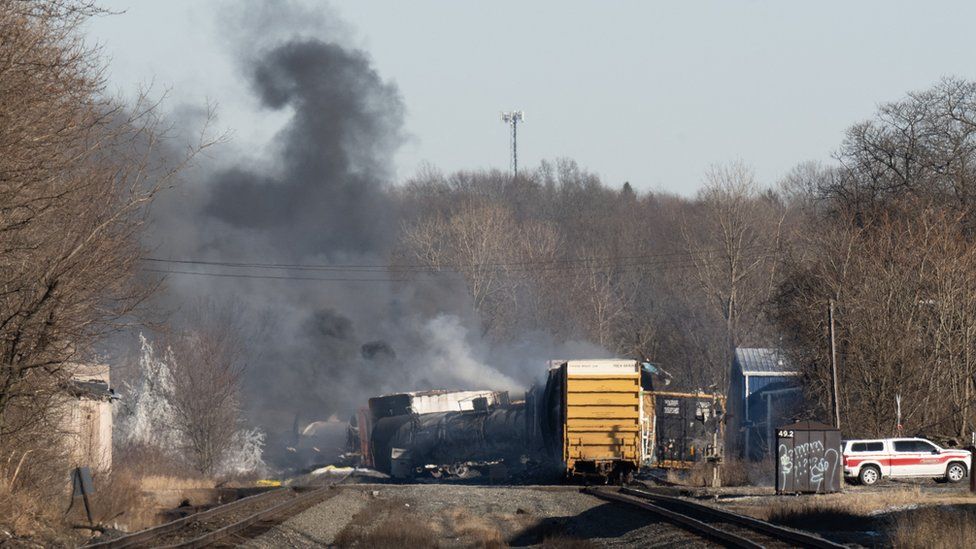ARTICLE AD BOX
 Image source, Dustin Franz/AFP via Getty Images
Image source, Dustin Franz/AFP via Getty Images
Smoke billows from a derailed train car in East Palestine, Ohio
By Kayla Epstein
BBC News, New York
On 3 February, a Norfolk Southern freight train carrying several potentially dangerous chemicals derailed in East Palestine, Ohio. The accident has caused residents to fear for the safety of the air and water, though government officials say that both are now safe.
The US Environmental Protection Agency, which is involved in the response, published a list of the train's cargo. While some cars held more innocuous substances, including malt liquors, semolina and frozen vegetables, about 11 of them were carrying chemicals with potentially toxic effects. Some of those containers leaked or burned during the accident.
Some of the chemicals onboard that have caused concern are vinyl chloride, butyl acrylate, benzene, ethyl hexyl acrylate and ethylene glycol monobutyl ether.
Vinyl chloride and butyl acrylate were the primary two chemicals released in the incident, the Ohio Environmental Protection Agency told the Washington Post."There's no question that there are chemicals in the mix that have been associated with serious health effects, including cancer," Keeve Nachman, a professor of environmental health and engineering at Johns Hopkins University, told the BBC. "What's really missing is information about how people come into contact with these chemicals in the air, drinking water or through soil."
Additionally, when burned, these chemicals can create new and potentially dangerous compounds, he said.
Residents in and around East Palestine have reported experiencing headaches, sore throats, and watery eyes. About 3,500 fish died off in the nearby creeks around the town after the incident, the Ohio Department of Natural Resources said on Tuesday. On Wednesday night, hundreds of angry residents gathered for a town hall in East Palestine to demand answers.
Though state and federal agencies have given the municipal water supply and air a clean bill of health, they have also encouraged residents to use private and well-water, to drink bottled water and avail themselves of free government testing. Ohio Governor Mike DeWine also suggested residents drink bottled water as a precaution.
Here's what we know about the chemicals on the train, their uses, and their potential impacts on people and the environment.
Vinyl chloride
Vinyl chloride is a colourless, odourless gas that is used to make PVC, a form of plastic used in many everyday objects.
However, vinyl chloride is also a known carcinogen and can cause negative impacts depending on the time and amount of exposure. It can cause headaches and nausea, or lead to serious conditions like liver cancer.
On 6 February, officials conducted a controlled release of vinyl chloride after temperatures in one of the freight carriages rose dangerously. Governor DeWine said the release was necessary to prevent an explosion, which could have blasted deadly shrapnel through the town.
The vinyl chloride release caused an ominous pillar of black smoke to rise high above East Palestine. Though officials said it was safe for residents to return a couple days later, environmental experts were more sceptical.
When vinyl chloride burns, it can release two toxic gases: hydrogen chloride and phosgene.
Butyl acrylate
Butyl acrylate is a colourless liquid with a fruit-like odour. It is used in the making of polymers, resins and paints.
Exposure can lead to irritation of the nose and eyes, nausea, vomiting and allergic reactions, according to the New Jersey Department of Health. Repeated exposure can cause lung cancer.
According to the EPA's disclosure about the train's cargo, an entire load of Butyl acrylate was lost in the crash to spills and fire.
Benzene
Benzene, a colourless or light-yellow liquid that can evaporate very quickly. It is one of the most commonly used chemicals in the US, and is used in common substances like plastic, resin, nylon and some forms of dyes, pesticides or detergents.
Benzene can also occur naturally, from volcanos or forest fires, and is a part of crude oil, gasoline and cigarette smoke, according to the US Centers for Disease Control.
Exposure to benzene through breathing or ingestion can cause symptoms like drowsiness, dizziness, tremors, vomiting or sleeplessness. Very high levels of exposure can lead to unconsciousness or death, per the CDC. Long-term exposure of a year or more could cause issues with blood, bone marrow or the immune system.
Ethyl hexyl acrylate
Ethyl hexyl acrylate is a compound. It is a colourless liquid with an acrid smell, according to the CDC, that can pose dangers if inhaled, consumed or absorbed through the skin or eyes.
The compound can irritate the eyes, skin and respiratory system.
Ethylene glycol monobutyl ether
Another compound on board the train, ethylene glycol monobutyl ether, can be used in paints and varnish. It is highly flammable, according to the National Oceanic and Atmospheric Administration. Contact with the compound's vapours can irritate the eyes and nose, or lead to nausea, headaches, dizziness and vomiting.
Two main risks stemmed from chemical exposure, Mr Nachman said. Long-term, lower-level exposure to harmful chemicals could result in issues like cancer. Meanwhile, shorter-term, highly-concentrated exposures could lead to the symptoms mentioned above, but also risks for pregnant women and developing children.
The data presented by officials so far did "not paint a clear enough picture of potential exposures," Mr Nachman said.
"The bottom line is this: we need to know if there are continuing chemical releases, what they are, the ways people may be exposed - air, water, and in their homes - and how we can eliminate their exposures," Mr Nachman said.

 2 years ago
73
2 years ago
73








 English (US) ·
English (US) ·